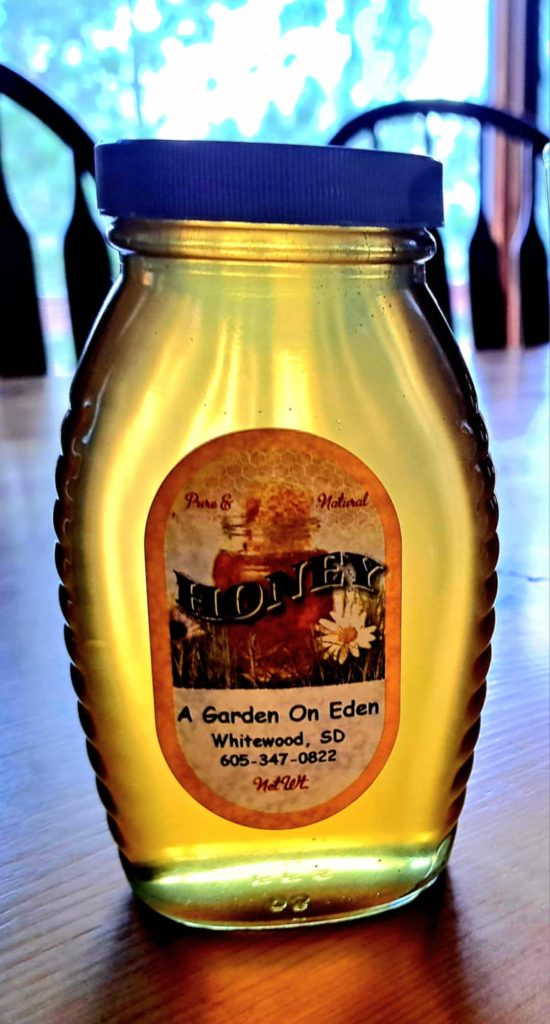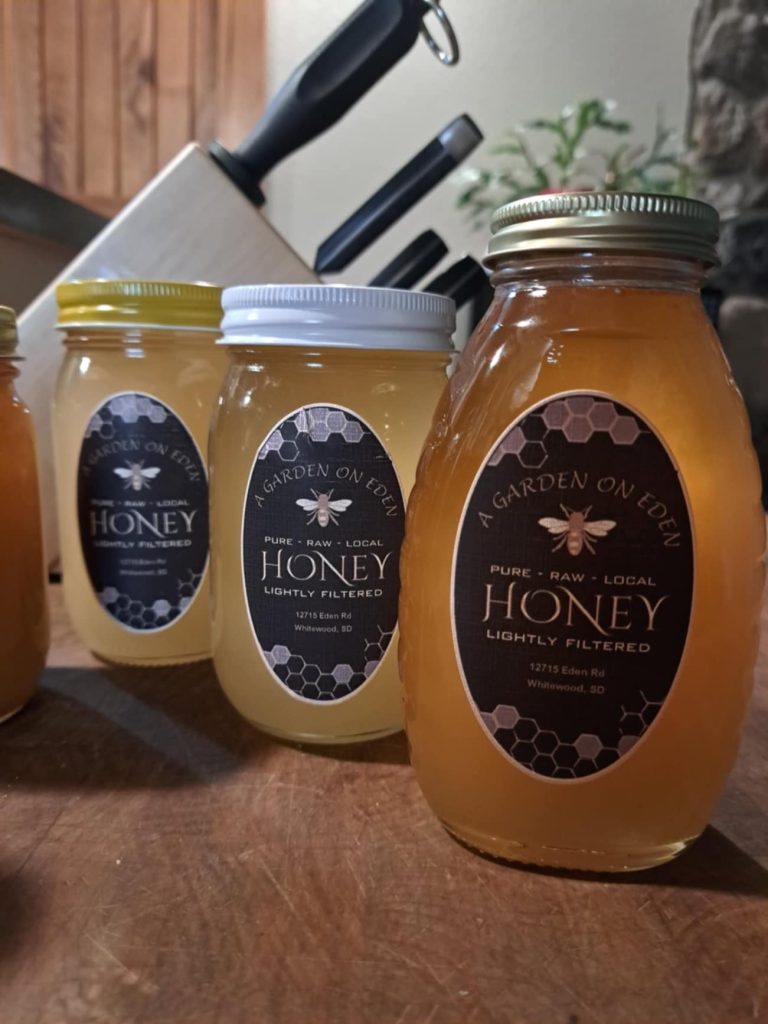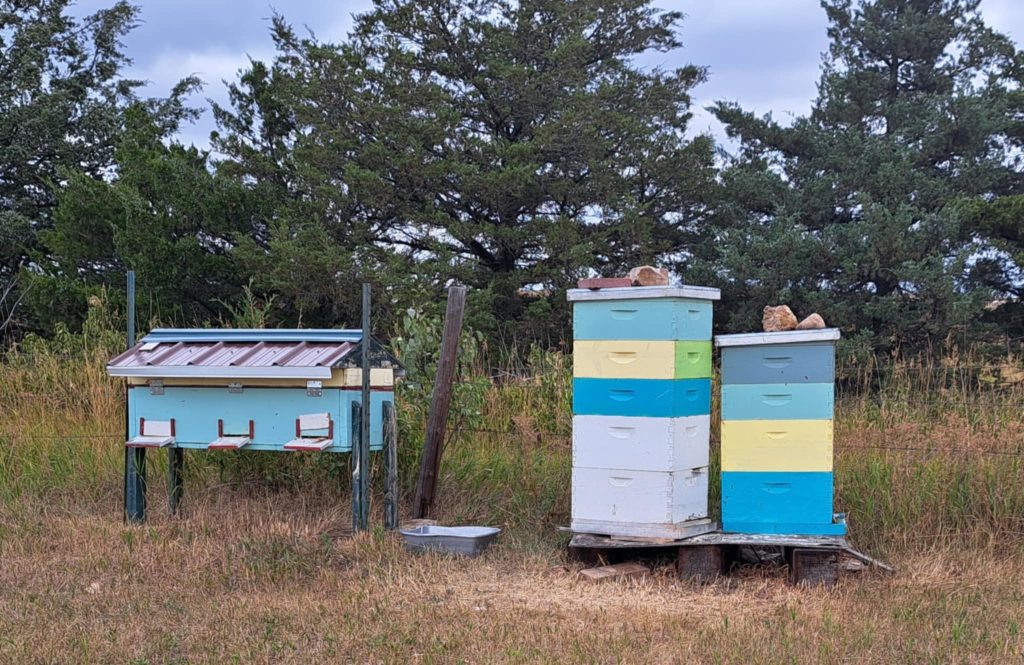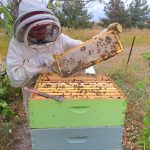2025 Spring Homeland | Sweet Success: Tips from Experienced Beekeepers
Honeybees play a vital role in food production, and in turn provide delicious and nutritious honey and a variety of other useful products.
“Anyone can put a hive of bees on their own land,” said Eric Andress, who owns and operates Grand River Honey Company out of Hettinger, North Dakota.
“One thing that’s very important for a hobbyist is to become educated in the diseases, mites, viruses and other problems bees have,” Andress said. “You can buy a hive at Runnings, but if all of a sudden, it’s dying and you don’t know what’s going on, you won’t know how to treat the bees. Join a local beekeepers club so you have people to talk to.”
Online courses are available “with all kinds of tutorials,” Andress said, and your local extension service will also be able to provide expert resources.
“Beekeeping is big in 4-H, and it’s a good project for kids. For people in town, it can be a way to promote pollinators.”
Most states require hobbyists to register their hives. Each state may have different rules about registering hives and how close hives can be located to other hives.
“Check with your state Department of Agriculture,” Andress said. “Some require you to register your hive location and some don’t. It’s your responsibility to do your part.
Beekeeping is not out of the question for someone living in town, Andress said.
“Lots of people are keeping bees in urban settings. When your hive location is registered, you will get notified of spraying, or mosquito fogging in the area. Aerial sprayers are required to notify beekeepers [including registered hobbyists] when they are going to spray, so you might want to get on the list so you get notice ahead of time.”
Boernsen Bees
Marlene Boernsen and her family started keeping honeybees twenty years ago. She runs the family business, Boernsen Bees, in Ocheydan, Iowa. Over the past twenty years the business has grown exponentially.
Boernsen supplies bees, equipment, queens and advice to aspiring beekeepers.
“If you call me and tell me you want to get started with bees, the first thing I’ll tell you is to find a mentor and take a class. There are so many details to know that make it easier. You can find a class with the extension service and there are lots of options online,” she said. “A mentor is really important.”
Boernsen advises getting new equipment when starting out.
“It’s best to get all new frames, boxes and foundations,” she said. “A disease called American foulbrood can live in the wooden frame and the comb for basically 100 years. You should get new equipment so you can start out without disease.”
Each hive must have a queen bee.
“Find someone who has a package of bees or a nucleus, called a nuc,” she said. “Both of those options will have a queen bee included.”
Taking a class provides an opportunity to learn the proper terminology used by beekeepers, which will be important when it comes to asking for advice from your mentor.
“Part of your education should include what flowers bees like,” Boernsen said.
Getting perennials established in a place where you can water them may be a step to take before acquiring a hive. Bees need flowers: a lot of flowers, a diversity of flowers, and a succession of flowers blooming throughout the summer. Bees can work some varieties of flowers but not others.
“Bees need an acre of flowers per colony,” Boernsen said. “If you start out with an acre of dandelions, then you’ll need an acre of whatever blooms next, or they will not survive.”
Toward the end of the summer, when flowers are dwindling, a larger colony of bees may rob out a smaller colony, one reason for the rules for a two- or three-mile distance between hives.
“As long as there are enough flowers, you won’t risk any fighting, or a colony of bees leaving a hive, Boernsen said. “You can put a robber screen on a hive to prevent the honey being stolen by a different hive.”
Along with plenty of flowers, bees also need access to water.
“Bees put water drops inside the colony as an air conditioning system,” Boernsen said. “They put drops of water on the frames. The entrance bees fan the air in with their wings on one side and out on the other, and the droplets of water they put in help keep the inside of the hive cool.”
Bees love mud puddles, Boernsen said. But if the weather is dry, a pan or tub of water with a board floating in it or rocks setting in it will give them a chance to get water without drowning.
Handling bees safely requires a slow, calm approach. While most reactions to stings are minor, be aware of any allergic reactions you have had to bee or wasp stings.
“Wear as much protection as you feel comfortable with,” Boernsen said. “I wear a full coverall, veil and gloves. Some people encourage you not to wear gloves, but I don’t want to be slowed down by picking stingers.”
Using a smoker helps calm bees down.
“Work slowly, try not to be in a hurry, and use care when lifting frames so you’re not crushing bees,” she said. “I think bees can smell fear, they can sense it. I know a [beekeeper] who is a really calm person and I don’t think he wears a suit or gloves, or even a veil.”
Good ventilation and moisture absorbent material under the lid of the hive are important when cooler weather arrives.
“Preparation for wintering your hives starts in August,” Boernsen said. “You want a good-sized cluster that is almost free of mites going into winter.”
The Varroa mite lives on bees and reproduces with the pupae. Too many mites in a hive will cause bees to die, especially in the colder months of the year.
“There is a lot to wintering: making sure the queen is laying consistently, making sure your Varroa mite load isn’t too heavy. You also want to make sure they have 80 to 100 pounds of honey in the brood chamber by the end of October,” Boernsen said.
“It is good to have protection from prevailing winds; a windbreak of straw bales or a couple sheets of plywood will work, but ventilation is a bigger issue than insulation. A lot of people want to close up the hive and put insulation all the way around the box, but the bees create the warmth they need, and the sun hitting the hive creates condensation that rains down on them when it warms up in the winter. They need to stay dry.”
Boernsens got their start with honeybees when Marlene’s husband Larry helped an 80-year-old beekeeper in the area.
“The guy said, ‘You need your own bees,’ so we all took the class the extension office was putting on in the spring of 2004. The instructor shared a lot of the value-added products you can make with honey.”
That first year, Marlene made creamed honey and took it to sell at their local county fair. These days, Boernsen Bees has a presence at local farmers’ markets and fairs nearly every weekend of the summer. Marlene took an entire pickup load, nearly 2,000 pounds of honey, to the Iowa State Fair in 2024. They have collaborated with another local business to make flavored carbonated drinks and energy drinks using their honey, and offer a wide variety of flavored creamed honeys, beeswax lip balm, salve and lotions, as well as honeycomb and, of course, honey. They have honey on the shelves of many area grocery stores and other retail locations.
Boernsen created her beeswax lotion for herself initially.
“My hands were so rough from gardening and diapers,” she said. “When it worked so well, I started offering it to people.”
As her business has grown, Boernsen has expanded to provide a variety of services for other beekeepers in a wide area.
“We do custom extracting, we sell bees, packages, nucs and queens; we sell equipment too. We can get people pretty well set up, plus I am available for mentoring,” she said.
“It doesn’t always make sense economically to raise your own bees because you want to use the honey. I could buy five gallons of honey cheaper than buying a hive of bees and trying to manage them. But there’s more to it, a lot of people tell me they don’t care about the honey, they just like bees.”
Garden of Eden
A decade ago, at age 65, Jan Quickstad decided to try beekeeping.
“I have always been a gardener, kept chickens, grown flowers, and done a lot of canning and baking,” she said. “I used to subscribe to Mother Earth News, and in one issue the featured articles covered gardening, canning, growing grapes and keeping bees. I already did two of those things, so I decided to try grapes and bees.”
The grapes “have not worked out so well,” but she is going strong with the honeybees.
“The first couple of years I was afraid of them, until I realized those suits do work.”
The last couple of years, Quickstad has used a horizontal hive.
“It looks like a little coffin on legs,” she said. “The frames are side by side in it, rather than stacked. It holds 32 nine-inch-deep frames. Regular supers are only six inches deep.”
Quickstad split her hives multiple times in 2024, taking some eggs and larvae in a frame along with their nurse bees, and putting them into a new container. The nurse bees make a queen by feeding one of the larvae a special diet of royal jelly.
Quickstad started out with Italian honeybees, but has shifted to Carniolians, which originate from Slovakia and Hungary in Eastern Europe. In 2024, she decided to try Russian bees, and has been pleased with the fertility and productivity of the Russian queen and her new daughter, the queen produced after Quickstad split the hive.
“I looked in a month later and there was all kinds of brood in there,” she said. “She takes after her mom. I had to add all kinds of frames.”
Quickstad doesn’t wait for the end of the season to harvest all of the supers at once. That, she said, would be “overwhelming.” Instead, she takes out twenty frames or so at a time throughout the summer as the bees fill them.
“That way I don’t have to lift out big heavy boxes and I don’t have to extract 120 frames at once,” she said.
“By the end of February or early March, my two hives were just boiling with bees,” she said. “I couldn’t split them then, I had to wait till April or May.”
Little observations can make a big difference.
“My first big hive I’ve split twice, but it’s not producing as well. I noticed with the heat that they’re producing through the center, not going to the outside walls to fill the frames. That hive is more out in the open, getting direct sunlight. The other big hive is under some maple trees, so it gets dappled light. I’ve already pulled 24 frames of honey out of that one,” Quickstad said.
They plan to build a slatted roof for the first hive so that it gets a little shade. She also tried a new venting system this year.
“The sun is so intense, we built a frame like a picture frame to set on top of the hive and stapled on some screen. That way I can prop the lid open and nothing can get in or out and the hive is vented.”
On chilly nights she can easily put the lids back down.
The queen that comes with the package “hasn’t laid any eggs yet, and they will ship those,” Quickstad said. “There are four to six frames in a nuc with a queen that is already laying, and they don’t ship nucs.”
When you put your package of bees in their box, you will need honey in it for them to eat. The queen needs to be well fed to lay eggs. “Summer bees” only live four to six weeks, so a prolific queen is important for the productivity of a hive. “Winter bees” live four to six months, and Quickstad said that the queen starts to lay winter bee eggs sometime in August or September.
Quickstads insulate the hives for winter with R-30 Styrofoam panel on top, R-6 on the sides, and set the hives tipped just a little bit so that condensation will run down the wall and not drip on the bees.
“My queens are laying by March,” she said. “I make sure to put pollen patty in there to feed the larvae.”
In late February and early March, Quickstads have noticed the bees already bringing pollen to the hive.
“We decided it was from the cedar trees,” she said. “Next the dandelions bloom, then the honey locust. The blossoms are so tiny you can’t hardly see the flowers. I’m trying to get linden trees growing, the bees like them.”
Late summer finds the bees feasting on sunflowers, gumweed, tasseling sweet corn, and second cutting alfalfa that was too short to cut for hay.
“We are surrounded by alfalfa; in the spring the honey is often an alfalfa and sweet clover mix. Later in the summer we depend on gumweed and some late alfalfa to pick up the slack. We like the gumweed honey, we think it has more flavor.”
If there is a dearth of bloom, “I feed honey back to the bees,” Jan said. She chooses not to feed her bees processed sugars. “If you put sugar water or corn syrup out in the summer, they’re going to fill the comb with that and then you’re harvesting sugar. That’s not fair to the consumer.”
Quickstad keeps an eye on the moisture content of her honey with a simple tool.
“If there’s too much moisture it will ferment,” she said. “You want it to be no more than 18%. Mine is usually around 16% when I pull the frames.”
Her extractor is a hand crank machine that only holds two frames.
“It works by centrifugal force,” she said. “It looks kind of like an old-fashioned ice cream maker. It doesn’t take me very long.”
She’s looking at a new extractor that would hold up to eight frames, but said that her hand crank machine is faster than an electric one she compared it with.
“The hardest thing about extracting for me is uncapping the comb,” Jan said. “I don’t use an electric knife; sometimes it will burn the honey or the wax, sometimes the comb is not built out far enough for a nice clean cut.”
After burning herself several times with an electric knife, she switched to a hand operated tool.
“It looks like a fork with long, skinny teeth,” she said. “It is tedious, and another reason I only do a few frames at a time when I extract. But it’s my time.”
Quickstad’s son and family live in Texas, and keep asking Jan to bring them honey.
“They say it tastes better than Texas honey,” she said.
Glossary:
American foulbrood – A brood disease of honey bees caused by the spore-forming bacterium, Paenibacillus larvae. The spore stage of the bacterium can remain viable for many years, making it difficult to eliminate the disease.
Apiary – Colonies, hives, and other equipment assembled in one location for beekeeping operations; also known as a bee yard.
Bee hive or Beehive – An artificial cavity for a bee colony to live in, usually a box or boxes with movable frames.
Brood – Immature bees that are still inside their cells. Brood can be in the form of eggs, larvae, or pupae of different ages.
Brood chamber or Brood nest – The part of the hive in which the brood is reared; may include one or more hive bodies and the combs within.
Cappings – A thin layer of wax used to cover full cells of honey. This layer of wax is typically sliced from the surface of a honey-filled comb so that the honey can be extracted.
Cluster – A large group of bees hanging together, one upon another. See also: Winter cluster.
Colony – The queen, brood, drones, and all the worker bees living together in a single hive or other nest.
Comb – A sheet of six-sided wax cells made by honey bees to hold brood, honey, nectar, and pollen. A sheet of comb will have a layer of cells on each side, united at their bases.
Comb honey – Honey harvested and sold in the comb. It is produced either by cutting the comb from the frame (cut-comb honey) or when the comb is built in special frames which allow for its easy removal without cutting.
Creamed honey – Honey which has crystallized under carefully controlled conditions to produce tiny crystals and an appealingly smooth texture. Often a starter or seed is used to help control the crystallization.
Drone – The male honey bee. Produced from unfertilized eggs.
Extraction – The process in which honey is spun out of frames using centrifugal force with a honey extractor.
Extractor – A machine that removes honey from the cells of comb by centrifugal force.
Foundation – A manmade thin sheet of beeswax or plastic embossed on both sides with the shape of cell bases. Used to encourage straight combs in frames, and to support the combs built on the foundation.
Frame – A rectangular wooden or plastic framework, designed to hold comb and hang in a hive box.
Hive – A manmade structure used by a colony of bees as a nest cavity.
Nucleus or Nuc – A small colony of bees consisting of fewer frames than a typical hive, usually housed in a smaller hive box. A nuc usually consists of three to six frames of comb and is used primarily for starting new colonies or rearing or storing queens.
Nurse bees – Young bees, usually three to ten days old, that feed and take care of developing brood.
Pupa (plural Pupae) – The third stage in the honey bee life cycle, during which it changes (pupates) from a larva to an adult bee.
Queen – A female bee with a fully developed reproductive system. Larger and longer than a worker bee.
Robbing – Stealing of nectar or honey by bees from other colonies. More common during a nectar dearth.
Robbing screen or Robber screen – A device that fits over the entrance of a hive, baffling arriving robber bees while allowing the resident bees to come and go.
Royal jelly – A highly nutritious glandular secretion of young bees, used to feed the queen and young brood.
Varroa mite or Varroa destructor – A devastating parasitic mite of honey bees, responsible for the deaths of many colonies due to weakening the bees and transmitting multiple bee viruses.
Veil – A hat, helmet, or headpiece including a screen of wire or fabric netting, used to protect the beekeeper’s head and neck from stings.


























